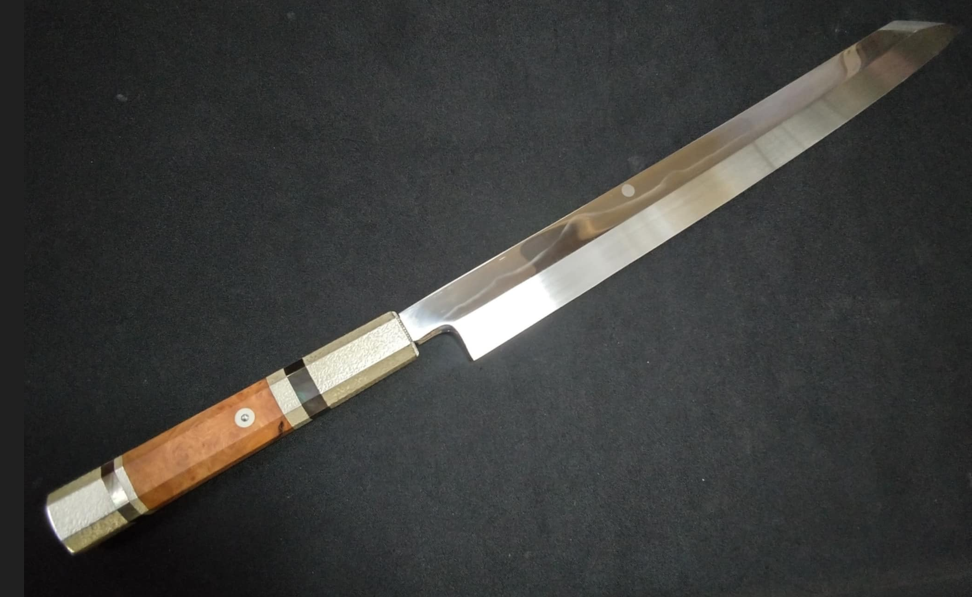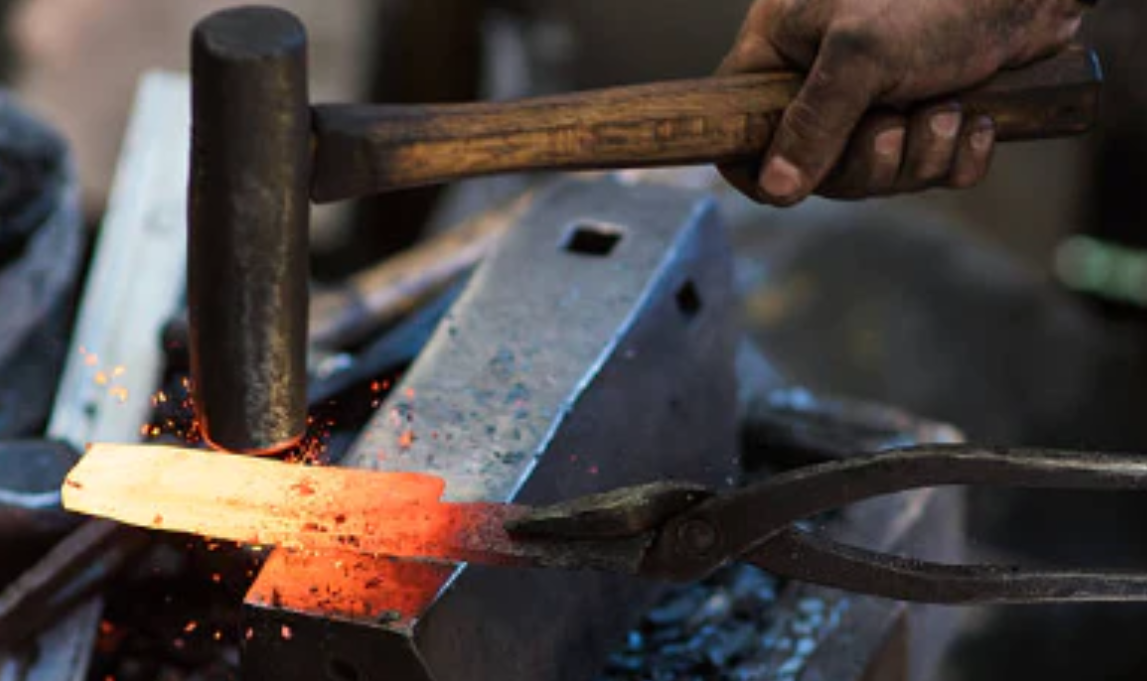
The Ultimate Sharpness! Unveiling the Secrets of "Honyaki" That Captivate Chefs
-
-
May 24, 2025
-
In the culinary world, often hailed as a "once-in-a-lifetime" tool, Honyaki is the aspiration of many professionals. Its overwhelming sharpness and almost artistic beauty deliver an unforgettable experience the moment you hold one. However, it's also true that they are more expensive than typical knives and demand extremely delicate handling.
This time, we'll delve into what makes this special "Honyaki" different from the commonly seen "Kasumi knives" and "Awase knives." We'll thoroughly explain everything from their structure to their manufacturing process, from the perspective of a knife specialist.
-

1. The Clever Structure of the Common "Kasumi/Awase Knives"
-
First, let's look at Kasumi knives (Awase knives), which are widely used in many homes and professional kitchens. These knives combine two metals with different properties, achieving excellent practicality and durability.
-
Specifically, they are made by laminating a "soft base metal (soft iron)" with a "hard blade steel (hagane)." The cutting edge and its reverse side are made of hard steel, while the majority of the knife, which supports it, is composed of softer iron.
-

This structure offers clear advantages:
- Impact Resistance: Even if a strong impact is applied during use or the blade should accidentally chip, the softer base metal acts as a cushion, often preventing fatal damage.
- Manufacturing Stability: Combining the base metal with the blade steel makes the knife less prone to cracking during the forging process, allowing for more stable and consistent quality in manufacturing.
2. Why "Honyaki" Is Considered Exceptional
-
So, why is Honyaki considered in a league of its own among countless other knives? The answer lies in their unique manufacturing process. Honyaki knives are fundamentally made from a single, hard piece of metal (hagane). (As a side note, some Western-style knives made from a single, hard stainless steel are often called "zenko" (full steel) and are distinguished from Honyaki.)
-
This simple yet highly advanced method is the source of their extraordinary performance. Let's unravel the specific reasons why Honyaki is treated as special, from a professional's perspective.
-

(1) "Tsuchioki" (Clay Coating) Creates Beauty and Functionality
One of the most distinctive processes in Honyaki manufacturing is "Tsuchioki" (clay coating). This involves applying a special clay to the surface of the knife when it's heated to high temperatures and then rapidly cooled in water during the "quenching" process.
By varying the thickness of this clay in different areas, differential hardening occurs in the steel after quenching. Specifically, the edge becomes hard, while other parts remain slightly softer, providing a "cushioning" property that absorbs impact. It's this contrast in hardness that manifests as the beautiful "hamon" (temper line) on the knife's surface. The hamon is a major appeal of Honyaki and a testament to the artisan's skill.
-
(2) The Choice of Quenching Medium: Water or Oil
During the quenching process, either "water" or "oil" is used to cool the heated steel. This choice significantly impacts the knife's final characteristics.
- Water Quenching: Results in an extremely hard finish, but also carries a higher risk of cracking. This is the method chosen by artisans pursuing ultimate sharpness.
- Oil Quenching: Less prone to cracking compared to water and often produces a cleaner hamon, but tends not to achieve the same level of hardness as water quenching.
Master craftsmen choose their quenching medium based on the desired sharpness and characteristics. Many of the finest Honyaki achieve their true potential through water quenching.
-
(3) A "Pure Blade" with Minimal Impurities
In the manufacturing of Kasumi knives, tiny iron powder-like substances are sometimes used as an "adhesive" when laminating the base metal and blade steel. While much of this iron powder is removed through forging, a minuscule amount can remain as an impurity, potentially affecting the final sharpness.
-
However, since Honyaki is made from a single piece of steel, there's no concern about such impurities being introduced. This allows for the pursuit of a purer, more ideal performance as a cutting tool.
-
(4) "Ideal Forging" for the Steel
Forging is a crucial process that influences a knife's sharpness. It involves hammering heated steel to refine its grain structure. During this, "low-temperature forging" is considered ideal, where the steel's temperature is kept as low as possible. Too high a temperature can coarsen the metal's grains, impairing the delicate sharpness.
Kasumi knives require heating the base metal and blade steel to high temperatures of around 1000 degrees Celsius for lamination. In contrast, Honyaki does not have this lamination step, allowing for forging at the optimal "low temperature" for the steel. This helps maintain a dense and uniform metal structure, resulting in exceptional sharpness.
-

(5) No Concern of Carbon Migration
From a technical standpoint, with Kasumi knives that combine different types of metals (soft iron with low carbon content and steel with high carbon content), there's a possibility of "carbon migration" where carbon from the steel moves into the soft iron. This could potentially prevent the steel from achieving its intended hardness.
Since Honyaki is made from a single, hard piece of steel, there's no concern of carbon migration. This ensures that the craftsman can achieve the precise hardness they intended.
-
(6) Stable with Less Age-Related Distortion
Kasumi knives, made from different metals, can experience slight distortion over years of use or changes in environment. However, since Honyaki is composed of a single steel material, they are less prone to age-related distortion. This allows them to maintain their superior performance over a long period.
3. Tips for Long-Term Care of Your Honyaki
-
While Honyaki boasts top-tier performance, its unique characteristics demand certain considerations and proper maintenance.
-

- Price Point: Due to the intricate manufacturing process and specialized techniques involved, they are typically three to four times more expensive than common Kasumi knives. However, considering their performance and the joy of owning such a piece, it's hardly an excessive investment.
- Sharpening Proficiency: Since the entire knife is made of hard steel, sharpening requires considerable time and skill. Moreover, these are very delicate knives, and improper sharpening can lead to damage.
- Importance of "Mendori" (Edge Dressing) for Whetstones: When sharpening, always ensure you perform "mendori" (edge dressing) on your whetstone. If the whetstone has sharp corners, the blade might catch on them, potentially causing chips or cracks in the knife.
Conclusion
-
Honyaki is more than just a "sharp" tool; it is a "work of art" where the artisan's skill and passion are condensed within its very creation. With its minimal impurities, ideal forging, absence of carbon migration concerns, and resistance to age-related distortion, it truly represents the pinnacle of perfection as a cutting instrument.
-

While it may be expensive and demand delicate handling, its unparalleled sharpness and beauty will undoubtedly enrich your cooking experience. Why not consider acquiring a Honyaki someday and experience its true value for yourself?
-
We hope this article has been helpful in your knife selection journey.
Honyaki: The Anatomy of an Ideal Blade
-

Honyaki knives are forged from a single piece of pure steel, allowing ideal low-temperature forging and maximum hardness.
They embody the highest level of sharpness, purity, and craftsmanship—beautiful, demanding, and unmatched in performance. -
The Price of Perfection: Why Honyaki Knives Are So Expensive
-
-
The Price of Perfection: Why Honyaki Knives Are So Expensive
Forged from a single piece of steel, honyaki knives are among the rarest and most demanding blades in Japan. Every strike risks failure, every quench flirts with disaster—yet the reward is unmatched sharpness and timeless beauty. In this video, we explore the secrets behind their creation, the purity of their materials, and the vanishing masters who keep this tradition alive.
-

Honyaki
Honyaki knives are the pinnacle of traditional Japanese craftsmanship, forged from a single piece of steel using the demanding tsuchioki clay-tempering method. Requiring extraordinary skill, they embody purity and precision—blades of breathtaking sharpness and beauty, treasured by chefs who seek nothing less than perfection.

The Soul of Craftsmanship
-
Honyaki — A Blade Forged in Resolve
In the world of knife making, there are many paths. Honyaki is the steepest trail—unforgiving, perilous, yet breathtaking for those who reach the summit.
Unlike most Japanese knives, which are built by laminating hard steel with soft iron for balance, a Honyaki knife is forged from a single piece of high-carbon steel—without a safety net. That purity makes it uncompromisingly difficult. In heat treatment, a difference of just a few degrees can mean disaster. The blade may warp, crack, or break. Sometimes you forge ten and not a single one survives. That is Honyaki. -
And yet, this is precisely why Honyaki represents the resolve of the craftsman. There are no shortcuts, no guarantees. Every time I face the forge, I steady my mind and whisper: “Let this one be born true.” It feels less like manufacturing, and more like a quiet devotion, a dialogue between steel and soul.
When a Honyaki succeeds, the result is unlike anything else. The edge glides effortlessly, the blade moves as if it already knows the cook’s intention. At times, it feels alive—an extension of the chef’s own spirit. That is the magic of Honyaki, the rare reward for so much risk. -
But remember: Honyaki is not a strong knife—it is a delicate one. Mistreat it, and it chips. Neglect it, and it rusts. Treat it with respect, and it will become a lifelong companion in your culinary journey.
-
This idea of “putting one’s heart into a tool” may sound uniquely Japanese. But hold a Honyaki in your hands, and you will understand—it is not just a knife. It is resolve, spirit, and beauty, captured in steel.

Experience the sharpness trusted by 98% of Japan’s top chefs — handcrafted in Sakai City.
Through our exclusive partnership with Shiroyama Knife Workshop, we deliver exceptional Sakai knives worldwide. Each knife comes with free Honbazuke sharpening and a hand-crafted magnolia saya, with optional after-sales services for lasting confidence.
KIREAJI's Three Promises to You
-

1. Forged in the Legacy of Sakai
From Sakai City—Japan’s renowned birthplace of professional kitchen knives—each blade is crafted by master artisans with over six centuries of tradition. Perfectly balanced, enduringly sharp, and exquisitely finished, every cut carries the soul of true craftsmanship.
-

2. Thoughtful Care for Everyday Use
Every knife includes a hand-fitted magnolia saya for safe storage. Upon request, we offer a complimentary Honbazuke final hand sharpening—giving you a precise, ready-to-use edge from day one.
-

3. A Partnership for a Lifetime
A KIREAJI knife is more than a tool—it is a lifelong companion. With our bespoke paid aftercare services, we preserve its edge and beauty, ensuring it remains as precise and dependable as the day it first met your hand.











